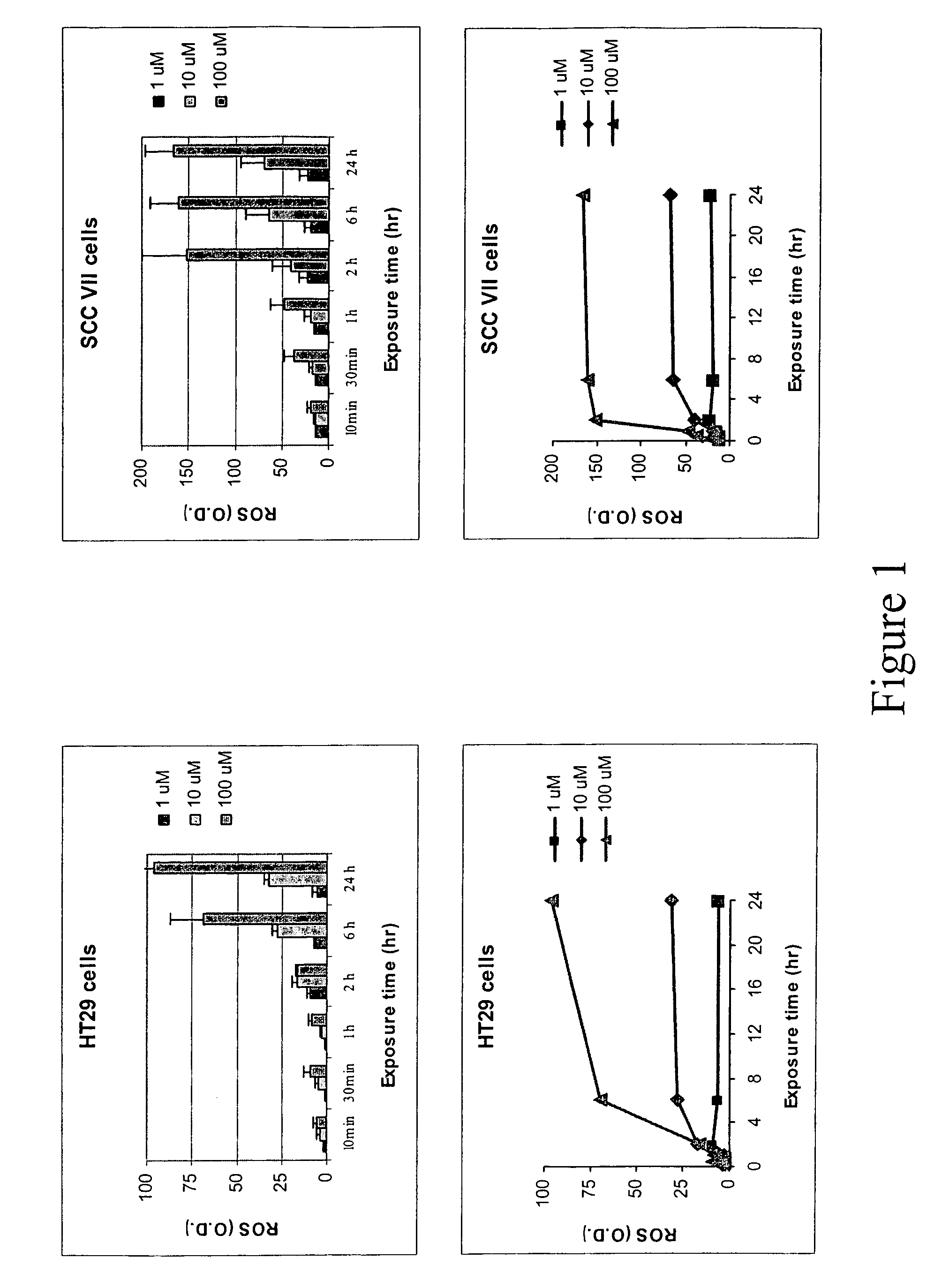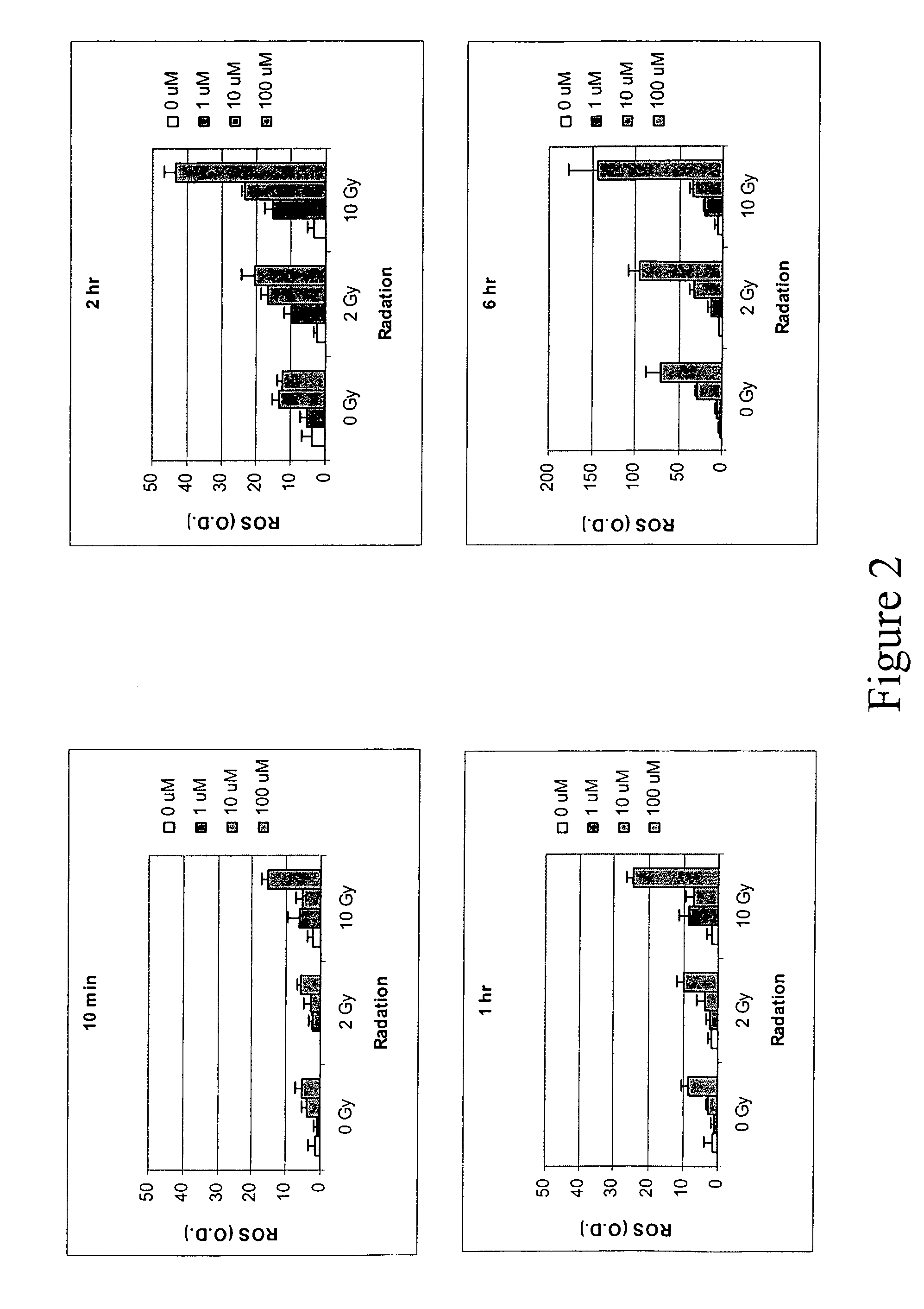Cyclic nitro compounds, pharmaceutical compositions thereof and uses thereof
a technology pharmaceutical compositions, applied in the field of pharmaceutical compositions of cyclic nitro compounds, can solve the problems of limited cancer therapy usefulness, selective differentiation between normal and abnormal cell proliferation,
- Summary
- Abstract
- Description
- Claims
- Application Information
AI Technical Summary
Benefits of technology
Problems solved by technology
Method used
Image
Examples
example 1
Production of ROS in Tumor Cells by ABDNAZ and Irradiation
[0140]Human colon cancer cell line HT29 cells and murine squamous cell carcinoma cell line SCC VII cells were grown in 96-well plate overnight at 37° C. and then a fluorescent probe 2′7′-dichlorofluorescin diacetate (DCFH-DA) was added at a concentration of 20 μM for 1 hour and then washed out. ABDNAZ was added in the growth media at concentrations of 1 μM, 10 μM or 100 μM. The green fluorescence was observed under a fluorescence microscope and measured using a microplate spectrofluorometer with an excitation at 488 nm and an emission at 525 nm. For cells that were treated with both ABDNAZ and irradiation, the plates were irradiated immediately after addition of ABDNAZ using a 137Cs source.
[0141]FIG. 1 shows the production of reactive oxygen species (ROS) in HT29 cells and SCC VII cells after exposure to ABDNAZ. The production of ROS was dose, time and cell line dependent. The ROS production in HT29 cells was gradually increa...
example 2
Inhibition of Proliferation of HL60 Cells by ABDNAZ
[0143]HL60 cell line which is an acute promyelocytic leukemia cell line was stably transfected with bcl-2 oncogene (HL60 bcl-2 cells). The HL60 neo cells were used as a control (HL60 neo). Cells were grown in RPMI1640 media in the presence of ABDNAZ at a concentration of 1 uM, 2 uM or 5 uM. The number of viable cells was counted daily for 10 days. The cell growth curves were shown in FIG. 4 which demonstrates that ABDNAZ inhibited cell growth in a dose-dependent manner. A dose of 5 uM of ABDNAZ inhibited cell growth by >95% and HL60 bcl-2 cells were as sensitive as neo cells to ABDNAZ.
example 3
Induction of Apoptosis of HL 60 Cells by ABDNAZ
[0144]Cells, prepared and grown as described in Example 2, supra, were collected at 8, 24, 48, and 72 hours after addition of ABDNAZ, and analyzed using FACS. FIG. 5 illustrates the percent of apoptosis vs. time in the presence of ABDNAZ. As can be seen in FIGS. 5, 6 and 7, ABDNAZ induced a very high level of apoptotic cell death in both HL60 neo and bcl-2 cells in a dose-dependent manner. ABDNAZ at 5 uM induced 95% and 78% apoptosis at 48 hours for neo and bcl-2 cells, respectively. At 2 uM, ABDNAZ produced apoptotic cell death that was very similar in HL60 neo and bcl-2 cells with peaks of ˜40% at 8 hours. FIGS. 6 and 7 illustrates the detailed histograms of FACS analysis for HL60 neo cells and HL60 bcl-2 cells, respectively.
PUM
| Property | Measurement | Unit |
|---|---|---|
| pH | aaaaa | aaaaa |
| pH | aaaaa | aaaaa |
| body weight | aaaaa | aaaaa |
Abstract
Description
Claims
Application Information
 Login to View More
Login to View More - R&D
- Intellectual Property
- Life Sciences
- Materials
- Tech Scout
- Unparalleled Data Quality
- Higher Quality Content
- 60% Fewer Hallucinations
Browse by: Latest US Patents, China's latest patents, Technical Efficacy Thesaurus, Application Domain, Technology Topic, Popular Technical Reports.
© 2025 PatSnap. All rights reserved.Legal|Privacy policy|Modern Slavery Act Transparency Statement|Sitemap|About US| Contact US: help@patsnap.com



